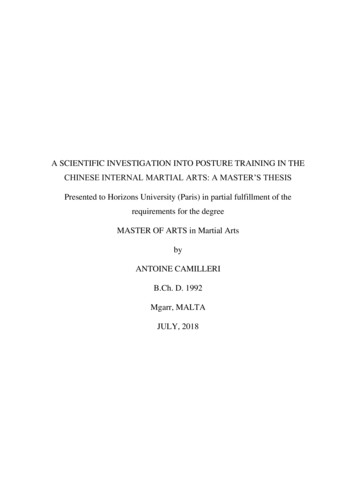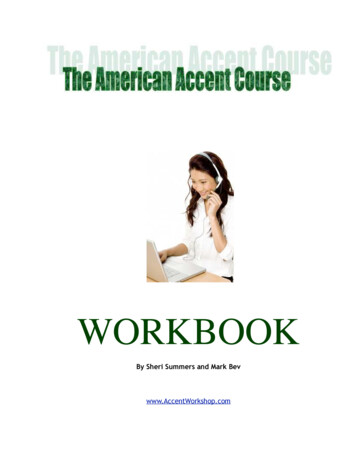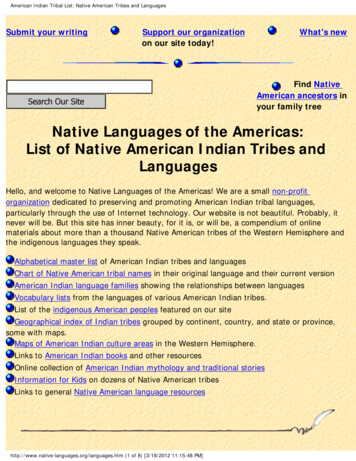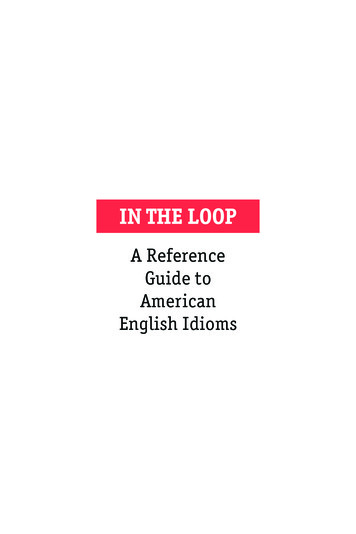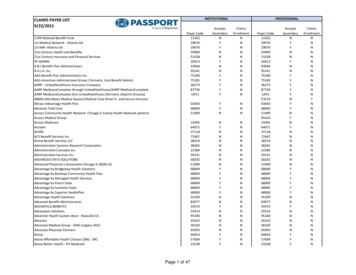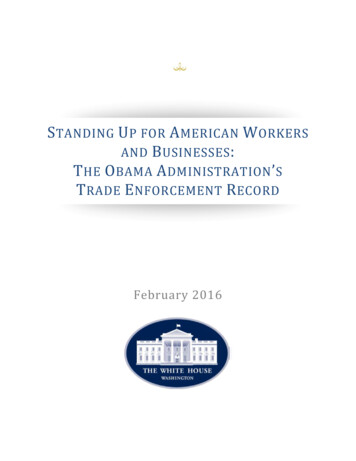
Transcription
S TANDING( U P(FOR( A MERICAN( W ORKERS( (AND( B USINESSES :(T HE( O BAMA( A DMINISTRATION ’ S (T RADE( E NFORCEMENT( R ECORD (((((February(2016
omic!Council!!
Contents1Executive Summary4Summary of the Trade Facilitation and TradeEnforcement Act of 2015 the Presidentis Signing Today6Trade Enforcement Has Been aPriority Under President Obama6A. WTO Cases12 B. Particular Issue Highlights14 C. Anti-Dumping and Countervailing Duty (AD/CVD)Enforcement And Other CBP Enforcement Efforts19 D. General Trade Agreements Compliance22 Appendix ATrade Enforcement 101:How We Enforce Our Trade Obligations25 Appendix BStakeholder Statements on theAdministration’s Trade Enforcement Work
PROTECTING AMERICAN WORKERS & BUSINESSES:The Obama Administration’sTrade Enforcement RecordExecutive Summary“I have made rigorous trade enforcementa central pillar of U.S. trade policy, andwe have moved aggressively to protectAmerican workers and to improve laborlaws and working conditions with tradingpartners across the globe.”President Barack Obama, 5/19/2015Today, President Obama is signing the bipartisan Trade Facilitation and Trade EnforcementAct of 2015 into law. Often referred to as “customs” legislation, it strengthens our tools for holding trading partners and foreign industries accountable on their obligations to trade fairly andopenly. This legislation represents an ambitious upgrade in our government’s trade enforcementcapabilities. From day one, the President and his Administration have set out to build a far morecapable enforcement system, and the result has been a record of trade enforcement victories thatare helping to level the playing field for American workers, businesses, farmers, and ranchers.The Administration has enlisted all of the relevant agencies and used all the tools at its disposal to identify, monitor, enforce, and resolve the full range of international trade issues, sothat American workers and businesses receive the benefits they are due under our trade and investment agreements. Those tools include pre-dispute engagement, which aims to push tradingpartners and industries to meet their obligations without having to resort to dispute settlementor other formal proceedings. However, if partners fail to live up to their obligations, formal disputesettlement mechanisms established under broad, multilateral agreements such as the WorldTrade Organization (WTO), as well as regional and bilateral free trade agreements, can help holdtrading partners accountable. Domestic trade laws also provide mechanisms for U.S. industryto seek remedies to level the playing field for imports dumped by foreign companies or unfairlysubsidized by foreign governments. For every case we bring, there are many multiples that are re-1
solved before coming to a public declaration of formal dispute proceedings. But where countriesor foreign industries are competing unfairly, we have not hesitated to act aggressively to protectAmerican workers and businesses, leveling the playing field for Made-in-America products. Todate, this strong enforcement record includes: Aggressively Pursuing—and Winning—Cases at the World Trade Organization (WTO):Since 2009, the Obama Administration has brought 20 enforcement cases at the WorldTrade Organization (WTO)—more than any other WTO member—achieving removal of barriers and increased export opportunities worth billions of dollars to American workers andfirms. This includes 11 complaints against China, substantially higher than the prior Administration. And the United States has won every one of these cases that has been decided—withwins against China on products from poultry to autos to high-quality steel. The Administration also took the first-ever safeguard action under Section 421 of the Trade Act of 1974against China to protect jobs in the domestic tire manufacturing industry and then successfully defended that action at the WTO. In addition to our record of success in complaintsagainst China, we’ve also won consequential cases against the EU for 18 billion in illegalaircraft subsidies; against India to end its illegal ban on U.S. poultry and other agriculturalproducts; against Argentina for import licensing affecting almost all U.S. exports; and againstthe Philippines for taxes on distilled spirits. Levying Anti-Dumping and Countervailing Duty Penalties on Foreign Industries and Trading Partners at the Highest Rate in 14 Years, Particularly Important to the Steel Industry: The United States is currently enforcing 325 antidumping (AD) and countervailing duty(CVD) orders and initiated 62 investigations in Fiscal Year 2015, which is the largest numberof investigations initiated in 14 years. Commerce and CBP are enforcing 149 AD/CVD ordersagainst foreign steel, representing nearly half of all cases. Making Labor Rights Enforcement a Priority: The Obama Administration has also madeunprecedented efforts to address labor rights, bringing the first ever labor case under a freetrade agreement (FTA)—against Guatemala—and undertaking initiatives with our FTA partner countries to strengthen workers’ rights in Honduras, Colombia, Panama, Bahrain, Jordan,Burma, Bangladesh, and others. Coordinating Efforts Across the Administration and Institutionalizing that Coordination:The President created the Interagency Trade Enforcement Center (ITEC) by Executive Orderin 2012, which brings together researchers, analytical resources, and expertise from acrossthe Federal Government into one organization, significantly enhancing the capability of theUnited States to investigate foreign trade practices that are potentially unfair to Americanindustry and American workers. The Trade Enforcement Act that the President is signing intolaw today will permanently establish the successor to ITEC, the Interagency Center on TradeImplementation, Monitoring, and Enforcement. The ITEC has provided crucial investigativeand analytical resources for WTO disputes brought against China and other trading partners,including export subsidies provided by China to its auto and auto parts manufacturers and toa variety of industries in so-called “Demonstration Bases.” Passing the Customs Bill to Strengthen Trade Enforcement Authority: The Trade Enforcement Act that the President is signing today will provide critical tools for the Administrationto hold its trading partners accountable. The bill strengthens the ability of Customs and Border Protection (CBP) to combat foreign companies trying to evade the duties that have beenimposed on them for violations of U.S. trade laws and their international obligations; includes2
new tools to enhance engagement with countries that do not adequately and effectively protect intellectual property rights; helps prevent the flow of counterfeit goods into the UnitedStates; authorizes a first-ever 15 million Trade Enforcement Trust Fund; and provides new,unprecedented tools to address unfair currency practices. Stepping up Customs and Border Protection Inspections: Today, in addition to the TradeEnforcement Act signing, CBP also announced that it has stepped up its reviews of steel imports, while requiring that all entry documents and duties be provided on certain shipmentsbefore cargo is released by CBP into the United States, referred to as “live entry.” For FiscalYear 2016, the President signed into law a 10 percent increase in trade enforcement fundingfor the Department of Commerce, which will be used to hire 38 new staff members to support the AD/CVD and trade compliance workload. Commerce will also hire five new staffmembers to support trade agreements compliance work. Increasing Funding for Trade Enforcement: The Administration is seeking robust fundingfor trade enforcement. The 2017 President’s Budget requests 606 million for CBP trade administration activities and 3,816 FTE to implement this work. This includes the salaries of CBPtrade and revenue staff within the Office of Field Operations, ten Centers of Excellence andExpertise for centralized processing and industry engagement, trade enforcement policy andprogram activities within the Office of International Trade, and the development and deployment of the Automated Commercial Environment (ACE). Together, these investments combine effective risk segmentation, enhanced targeting, and expanded shipper vetting to allowCBP to focus scarce law enforcement resources on the relatively small number of shipmentsthat have potential to cause harm. In addition, the President’s Budget funds the Departmentof Commerce’s International Trade Administration’s Enforcement and Compliance Programat 84 million, a 4.5 million increase over the 2016 enacted level. This includes 347 FTEwho work to take prompt and aggressive action against unfair foreign trade practices andforeign government-imposed trade barriers. The President’s Budget annualizes the 38 positions established by the 2016 Consolidated Appropriations Act, adding 12 FTE to address theurgent need for additional staffing caused by the sustained and significant increase in AD/CVD cases. At the Department of State/USAID, the Administration requests 45 million inthe President’s Budget to help less developed trading partners meet the high standards thatour agreements require.In the final year of the Administration, we are continuing to build on the Administration’senforcement record. This paper outlines a number of steps we are taking. 3
Summary of the Trade Facilitation andTrade Enforcement Act of 2015the President is Signing TodayThe Trade Facilitation and Trade Enforcement Act of 2015 that PresidentObama is signing today, includes new tools and resources to help ensurethat our trading partners live up to their commitments. This bipartisan bill: Establishes the Interagency Center on Trade Implementation, Monitoring, and Enforcementat USTR which brings together expertise from across government to aid in monitoring andenforcing U.S. trade agreements. This codifies into law an initiative first established by thePresident in his 2012 Executive Order that set forth an interagency approach to boostingenforcement efforts. Creates a Trade Enforcement Trust Fund to provide new resources – authorized at 15 millionper year up to a cap of 30 million total – for trade enforcement efforts. Improves our ability to target trading partners who attempt to evade U.S. antidumping orcountervailing duty orders. Bolsters enforcement tools to protect intellectual property rights, including by authorizingthe seizure of circumvention devices, and by facilitating the seizure of suspect merchandisethrough improved coordination with intellectual property right holders. Strengthens the prohibition on importing goods made by forced labor by closing a previousloophole that permitted imports of goods made with forced labor if consumption demandfor a good could not be met by American producers. The legislation removes the exception. Gives the United States unprecedented new measures to address unfair currency practices.The legislation creates a new mechanism to confront countries that engage in unfair currencypractices and requires the Administration to impose penalties on countries that fail to workwith us. Mandates a strategic multi-year plan for trade enforcement produced by the U.S. Customsand Border Protection and U.S. Immigration and Customs Enforcement. Establishes Centers of Excellence and Expertise for trade enforcement throughout U.S. Customs and Border Protection to bolster trade enforcement at ports of entry. Strengthens our ability to enforce intellectual property rights by creating a National Intellectual Property Rights Coordination Center and setting staffing and training requirements thatenhance the federal government’s enforcement of IP rights at our borders. Ensures that U.S. Customs and Border Protection personnel are trained in the detection, identification, seizure, and forfeiture of cultural property, archaeological or ethnological materials,and fish, wildlife and plants that are taken illegally.4
Requires a report on the effectiveness of trade enforcement activities including looking atfraud prevention and transshipments. Improves international cooperation among law enforcement and customs officials tostrengthen intellectual property rights enforcement. 5
Trade Enforcement Has Been aPriority Under President ObamaA. WTO CasesThe Obama Administration’s unprecedented enforcement efforts benefit American workers andU.S. industry by leveling the playing field and by demonstrating our commitment to upholdingtrade rules to support future American economic growth and jobs. This takes on even greatermeaning when we finalize cutting-edge new trade agreements like the Trans-Pacific Partnershipthat play to American advantages and contain the strongest labor and environmental standardsin history. The Administration’s trade enforcement record at the WTO has included:Bringing 20 Cases to the WTO and Winning Every Case That’s Been DecidedUnited States Trade Representative has lodged 20 WTO complaints since 2009, more than anyother WTO Member. Of those, USTR has prevailed in every case decided so far—we’ve won 12disputes through litigation and settled 1 case favorably.Significantly Increasing the Rate of Cases Against ChinaThe Obama Administration has also significantly increased the rate of cases brought against China compared to the last Administration, winning all seven of those decided to date and settlinganother favorably.Focusing on Key, Strategic Markets for U.S. ExportersSince 2009, USTR has focused on key, strategic markets, including: China (11 complaints); Indiaand Indonesia (3 complaints each); and the European Union, Argentina, and the Philippines (1each).Protecting Billions of Dollars of Opportunity for U.S. ExportsOur trade enforcement actions have sought to open and preserve major export markets, including: 1) Autos in China (China dropped AD/CVDs on more than 5 billion in exports); 2) Solar inIndia (an estimated 1 billion market); and 3) Poultry in China (challenging illegal duties for this 1 billion export market, by industry estimates).Ending Unfair Trade PracticesOur trade enforcement actions have targeted unfair trade practices—including seeking to end 18 billion in European Union subsidies to Airbus; eliminating restrictions on American-madeproducts through discretionary licensing on nearly 11 billion in annual exports to Argentina;and ending an unjustified ban on U.S. poultry in India, which is potentially a 300 million peryear exports market, by industry estimates.Benefitting Small Businesses That Represent 98 Percent of American Exporters98 percent of the American companies that export are small and medium-sized businesses.6
However, small businesses often lack the resources to take on unfair trade barriers. PresidentObama has targeted trade enforcement cases to take on policies that are specifically harmfulto our small business exporters, such as burdensome agricultural and technical regulations, re-20 Offensive WTO Complaints11 China Complaints (including compliance with WTO rulings)Value Added Tax (2015)Outcome: OngoingUSTR initiated a WTO challenge to Chinese measures exempting certain aircraft produced in Chinafrom a 17 percent value-added tax while imposingthose taxes on imported aircraft.Export Restraints on Raw Materials II (“RareEarths”) (2012)Outcome: WinWTO found in favor of the U.S. on China’s impermissible export restraints on rare earths, tungstenand molybdenum.Demonstration Base/Common Service PlatformExport Subsidies (2015)Outcome: OngoingUSTR initiated a WTO challenge to China’s measures that appear to establish a program of prohibited export subsidies. The measures, provide anunfair advantage to businesses located in China,distorting competition with American-made products.Broiler Products AD/CVD Determinations(2011)Outcome: WinWTO found in favor of the U.S. on China’s impermissible antidumping and countervailing duties onU.S. poultry product exports.Wind Power Equipment Prohibited Subsidies(2010)Outcome: Settled FavorablyUSTR issued WTO challenge against subsidiesChina provided to manufacturers in the wind power equipment sector. China terminated the challenged subsidy program.High-Tech Steel AD/CVD compliance (2014)Outcome: WinWTO found in favor of U.S. challenge to China’sfailure to follow WTO’s 2010 ruling, and Chinaterminated the duties. This case is the first-evercompliance proceeding brought against China inthe WTO.High-Tech Steel AD/CVD Determinations(2010)Outcome: WinWTO found in favor of the U.S. in a dispute challenging China’s impermissible antidumping andcountervailing duties on U.S. exports of high-techsteel.Export Bases for Automobile & AutomobileParts (2012)Outcome: OngoingUSTR challenged a Chinese export subsidies program to auto and auto parts enterprises in China.U.S. efforts to address this program are ongoing.Electronic Payment Services (2010)Outcome: WinWTO found in favor of the U.S. in a dispute challenging China’s impermissible rules discriminatingagainst U.S. suppliers of electronic payment services, such as credit and debit card companies.Autos AD/CVD Determinations (2012)Outcome: WinWTO found in favor the U.S on China’s impermissible antidumping and countervailing duties on U.S.exports of cars and SUVs. China terminated theduties on over 5 billion in U.S. exports.Export Restraints on Raw Materials (2009)Outcome: WinWTO found in favor of the U.S. in a dispute challenging China’s impermissible export restraints onnine key raw materials affecting steel, aluminumand chemical sectors.7
9 Other Complaints (including compliance with WTO rulings)IndonesiaImport Licensing III (2014)Outcome: OngoingUSTR is engaged in a WTO challenge to Indonesia’s wide-ranging import restrictions on fruits andvegetables (such as apples, grapes, and potatoes),animal products (such as beef and poultry), andother agricultural products.IndonesiaImport Licensing I (2013)Continued in Importan Licensing II/IIIOutcome: OngoingUSTR initiated a WTO challenge to Indonesia’swide ranging import restrictions on horticulturalproducts, poultry, beef, and other animal products.ArgentinaImport Licensing (2012)Outcome: WinWTO found in favor of the U.S. in a dispute challenging Argentina’s widespread restrictions on theimportation of U.S. goods.IndiaSolar Local Content II (2014)Outcome: WinUSTR won a victory at the WTO over Indian measures that discriminated against U.S. solar enerfgyequipment—a win that will benefit deployment ofsolar energy across the world and protect clean energy jobs in the U.S.IndiaPoultry (2012)Outcome: WinWTO found in favor of the U.S. in a dispute challenging India’s ban on various U.S. agriculturalproducts—such as poultry meat, eggs, and livepigs—allegedly to protect against avian influenza.IndonesiaImport Licensing II (2013)Continued in Import Licensing IIIOutcome: OngoingUSTR initiated a second WTO challenge to revisions Indonesia made to its wide ranging importrestrictions on horticultural products, poultry, beef,and other animal products.EULarge Civil Aircraft (“Airbus”) compliance (2011)Outcome: OngoingThe WTO upheld U.S. claims that EU subsidies toAirbus caused adverse effects to U.S. interests.USTR is now challenging EU’s failure to complywith its obligations to withdraw the subsidies orremove their adverse effects.IndiaSolar Local Content (2013)Combined with Solar Local Content IIOutcome: WinUSTR won a victory at the WTO over Indian measures that discriminated against U.S. solar energyequipment.PhilippinesTaxes on Distilled Spirits (2010)Outcome: WinWTO upheld U.S. claims that Philippine excise taxes8
strictive licensing requirements, and limits on American auto parts manufacturers. Several casesoffer especially important economic impacts for small and medium-sized businesses. These include WTO challenges against Chinese export subsidies for makers of auto parts, hardware andbuilding materials, furniture, and ceramics, Indian use of non-science-based import restrictionsto block poultry imports, and unfair import licensing rules in Argentina.CHINA-SPECIFIC WTO ACTIONSThe Obama Administration has been especially aggressive in its pursuit of WTO cases to seekredress for China’s unfair trade practices. Since 2009, under President Obama, the United Stateshas brought 11 WTO Complaints against China (more than half of the 20 total). Of those, USTRhas prevailed in every case decided so far—seven complaints won through litigation and one casesettled favorably:WINSTwo U.S. Victories Led China to Revoke Unfair Taxes on High Tech Steel from the UnitedStatesIn 2010, the Obama Administration successfully sued China when it effectively blocked U.S.steel imports through unfair duties. We disagreed when China said that it had brought its dutiesin line with WTO rules and sued China again. In 2015, the WTO again agreed that China wasbreaking WTO rules. This enforcement victory led to China reopening a more than 250 millionmarket for American steel exports of grain oriented electrical steel (GOES), directly benefitingour nation’s steelworkers. GOES is a high-tech, steel that is primarily used by the power generating industry in transformers, rectifiers, reactors, and large electric machines. AK Steel Corporation and Allegheny Ludlum, based in Pennsylvania, manufacture GOES in the United States.WINU.S. Victory in Complaint to Stop China from Discriminating Against American ElectronicPayment Services, Such As Credit and Debit CardsSeptember 2010, the U.S. challenged China’s restrictions and requirements on electronic payment services (EPS) for payment card transactions and the suppliers of those services. Each yearwell over one 1 trillion worth of electronic payment card transactions are processed in China. In2012, the WTO agreed with the United States that China’s measures discriminate against U.S.suppliers. China has taken some steps to address the problems identified by the WTO, and theAdministration continues to work with U.S. stakeholders and China to ensure American creditand debit card companies’ fair access to China’s market.WINWe Won a Complaint Against Unlawful Chinese Duties on U.S. PoultrySeptember 2011, the United States challenged China’s AD/CVD duties on U.S. exports of chicken“broiler products.” According to industry estimates at the time, the U.S. poultry industry stoodto lose approximately 1 billion in sales to China by the end of 2011. In June 2013, the WTOagreed that China’s measures were inconsistent with its WTO commitments. China issued a newmeasure in response to the WTO finding in 2014. The United States is reviewing that measure.9
WINWe Stood Up for American Auto Workers and Businesses and Got China to Terminate Arbitrary Duties on 5 Billion of Made-In-America AutosIn 2014 the Obama Administration won a major trade enforcement case against China on behalfof U.S. auto manufacturers and the more than 900,000 American automotive industry manufacturing workers around the country, from Michigan to Ohio to California. In that case, the WTOagreed with the United States that China’s imposition of antidumping duties and countervailingduties on American-made cars and sport-utility vehicles (SUVs) breached numerous international trade rules. In 2013, the United States exported over 60 billion of autos, with about 15percent of the total, going to China. China is now the second largest export market for U.S. autos,after Canada. China’s unjustified duties, which ranged up to 21.5 percent, affected an estimated 5.1 billion worth of U.S. auto exports in 2013, and were applied to well-known models such asthe Jeep Grand Cherokee, Buick Enclave, Cadillac Escalade, and many others.WINU.S. Victory Led China to Eliminate Export Restraints on Nine Raw Materials Important toMaking Steel, Aluminum, and Chemical ProductsIn June 2009, the United States challenged China’s export restraints on nine raw materials tocreate a level playing field for U.S. workers and businesses that manufacture downstream products in the steel, aluminum and chemical sectors. The export restraints enabled China’s downstream producers to obtain a dramatic competitive advantage by significantly decreasing theirinput costs. For example, in 2008, the input cost for coke was 36 percent less for Chinese domestic steel producers than their foreign counterparts. In 2011, the WTO found China’s quotasand duties to be inconsistent with its WTO commitments. In December 2012, China eliminatedthe offending measures.WINWe Forced China to Eliminate Export Illegal Export Duties and Quotas on Rare EarthsIn March 2012, the United States challenged China’s export restraints on rare earths, tungstenand molybdenum products. China is the world’s leading producer of rare earths, producing anestimated 130,000 metric tons of rare earth oxide, which accounted for approximately 97 percent of global production in 2011. In all, China’s export restraints on the materials at issue in thisdispute cover approximately 100 tariff codes. The United States brought this dispute to createa level playing field for U.S. workers and businesses that manufacture many important downstream products in the United States, including hybrid car batteries, wind turbines, energy-efficient lighting, steel, advanced electronics, automobiles, petroleum and chemicals. In late 2014,the WTO agreed with the United States and found that China’s export restraints are inconsistentwith WTO rules. China announced that it has eliminated WTO-inconsistent export duties andquotas on these products. The United States is closely monitoring China’s actions to ensure thatthese illegal policies are in fact discontinued and that China fully complies with its obligations.SETTLED FAVORABLYChina Backed Down and Eliminated Hundreds of Millions of Dollars of Subsidies to China’sWind Power SectorIn December 2010, following a petition from the United Steelworkers, the United States initiated a WTO case challenging subsidies that China provided to manufacturers in its wind powerequipment sector. The subsidies appeared to require the use of local content, at the expense offoreign manufacturers’ products. At the time of the dispute, grants provided under this program10
from 2008 to 2010 totaled several hundred million dollars. In response to USTR’s challenge,China terminated the challenged subsidy program.DEFENDED SUCCESSFULLYChina Lost its Challenge to Our Actions to Protect American Workers in the Tire IndustryThe Administration also took the first-ever safeguard action under Section 421 of the Trade Actof 1974 against China to protect jobs in the domestic tire manufacturing industry. Through theSection 421 safeguard, President Obama imposed tariffs on Chinese tires and later successfullydefended that action at the WTO.ADDITIONAL WINS AT THE WTOIn addition to the wins against China, the United States has prevailed in five other major WTOcomplaints that have been decided:WINBenefitted American Poultry Workers and Businesses by Taking on India’s Ban on U.S.PoultryIn 2015 the U.S. won a major victory for the U.S. poultry industry and its workers after suingIndia over an unfair ban on our poultry, meat, and eggs. The U.S. poultry industry, which directlyemploys hundreds of thousands of workers and consists of tens of thousands of family farms,has been particularly affected by India’s restrictions. The industry estimates that U.S. exports toIndia of just poultry meat alone could exceed 300 million a year once India’s restrictions areremoved – and are likely to grow substantially in the future as India’s demand for high-qualityprotein increases. Exports are important to the health of this industry. The United States exports18 percent of its poultry meat production, with U.S. domestic exports for poultry meat, eggs,and other poultry products worth approximately 6.5 billion to over 136 countries in 2014. Thissuccessful challenge at the WTO is an important step forward in fully opening India’s markets.WINCracked Down on Argentina’s Restrictions on U.S. Exports Across a Variety of ProductsIn 2015 the U.S. won a trade enforcement victory against Argentina that involved its widespreadrestrictions on the importation of a range of U.S. goods. The restrictions by Argentina affectedbillions of dollars in U.S. exports, including energy products, electronics and machinery, aerospace and parts, pharmaceuticals, precision instruments and medical devices, miscellaneouschemicals, motor vehicles, vehicle parts, and agricultural products. The following U.S. states represented the largest share of exports to Argentina in 2015, each exporting over 100 million ingoods that year: Texas, Louisiana, Florida, Washington, Michigan, New Jersey, Illinois, California,Tennessee, South Carolina, New York, Pennsylvania, Georgia, Ohio, North Carolina, Indiana, Wisconsin, Virginia, and Maryland.WINSChallenged India on Discriminatory Policies on Imported Solar CellsIn February 2013 and February 2014, the United States challenged India’s “localization” rules discriminating against imported solar cells and modules under two phases of India’s National SolarMission. The United States initiated the challege in order to ensure that world-class U.S. cleanenergy goods can compete on an equal footing and can continue to support American jobs andmanufacturing. The United States strongly supports the rapid deployment of solar energy around11
the world—including in India—but discriminatory policies in the clean energy space undermineeffortrs to promote clean energy by requiring the use of more expansive and less efficient equipment. The U.S. has consistently made the case that India can achieve its clean energy goalsfaster and more cost effectively by allowing solar technologies to be imported from the UnitedStates and other solar producers. In February 2016, a World Trade Organization (WTO) disputesettlement panel found in favor of the United Sta
Trade Organization (WTO), as well as regional and bilateral free trade agreements, can help hold trading partners accountable. Domestic trade laws also provide mechanisms for U.S. industry to seek remedies to level the playing field for imports dumped by foreign



